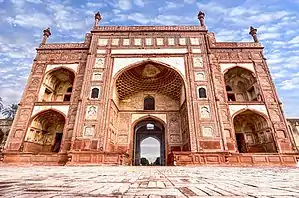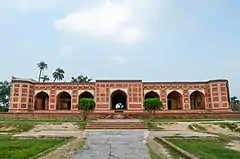Shahdara Bagh
Shahdara Bagh (Urdu: شاہدره باغ; meaning “King’s Way Garden”) is a historic precinct located across the Ravi River from the Walled City of Lahore, Pakistan. Shahdara Bagh is the site of several Mughal era monumentally, including the Tomb of Jahangir, the Akbari Sarai, Tomb of Asif Khan, Baradari of Kamran Mirza, and the Tomb of Nur Jahan.
Shadra Bagh شاہدره باغ | |
|---|---|
| Nickname(s): Shahdara | |
| Country | |
| Province | Punjab |
| City | Lahore |
| Administrative town | Ravi |
History

Shahdra can be translated as the door of kings and also known as "the way of kings". Shah translates as "king" and dra translates as the way. In the 15th century, Shahdra was the entrance gate of Lahore under the Mughal Empire. It hosts several historic Mughal architectural sites. These include the Akbari Sarai, the Tomb of Jahangir (who was the Emperor from 1605 to 1627), the tomb of his consort Nur Jahan, as well as the tomb of his brother-in-law Asif Khan. Shahdara Bagh is also home to Kamran's Baradari (Kamran Ki Baradari). Although this site was originally built on the Ravi River bank, the river changed course, covering the site near the Ravi Bridge. The small garden houses the tomb of Mughal Princess Dohita Un Nissa Begum (1651-1697).
Transportation
Shahdara Bagh railway station serves Shahdara and surrounding areas. Shahdara Metrobus Terminal Station is located on the north bank of river Ravi .
Gallery

 Interior of the Tomb of Jahangir
Interior of the Tomb of Jahangir

